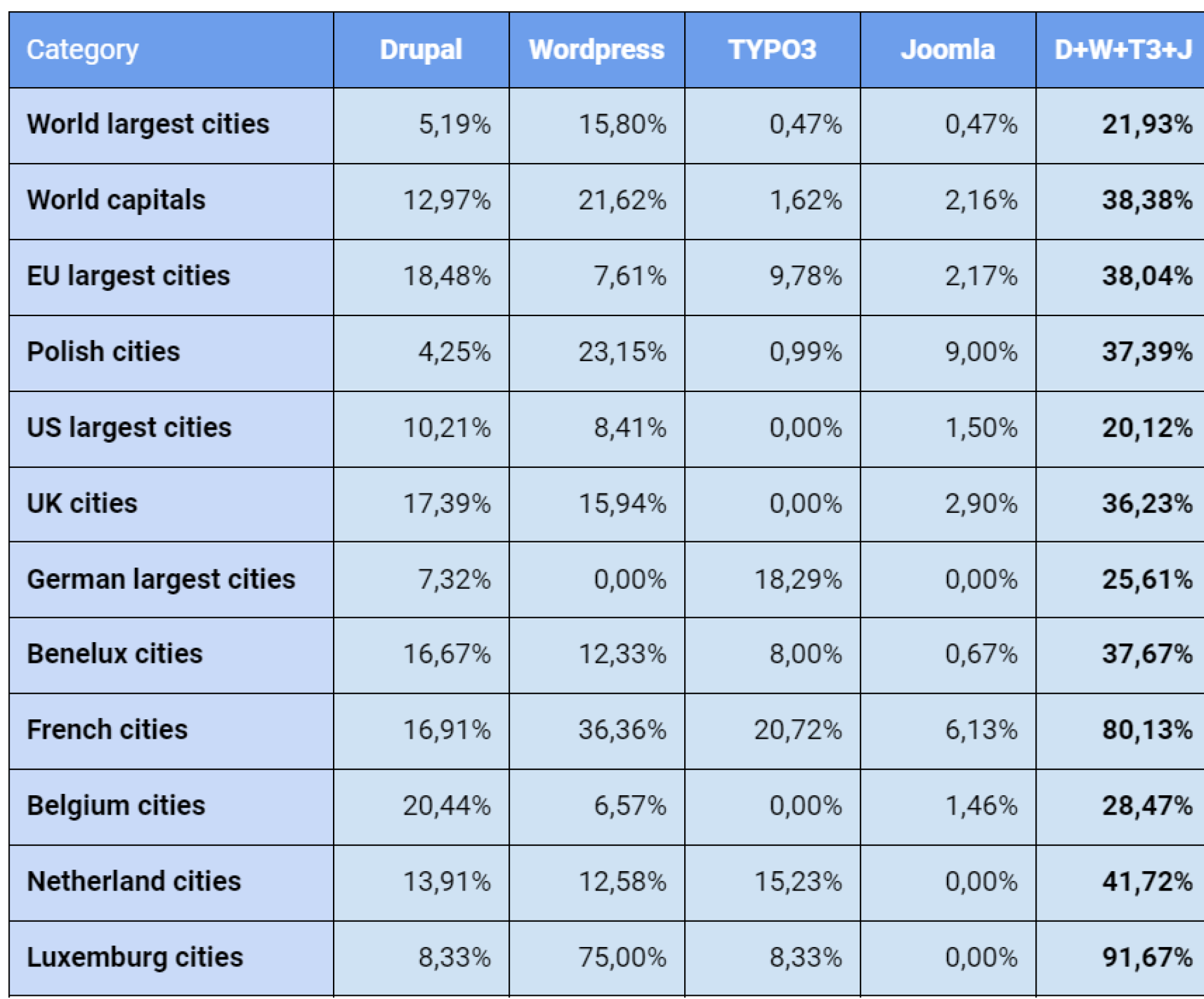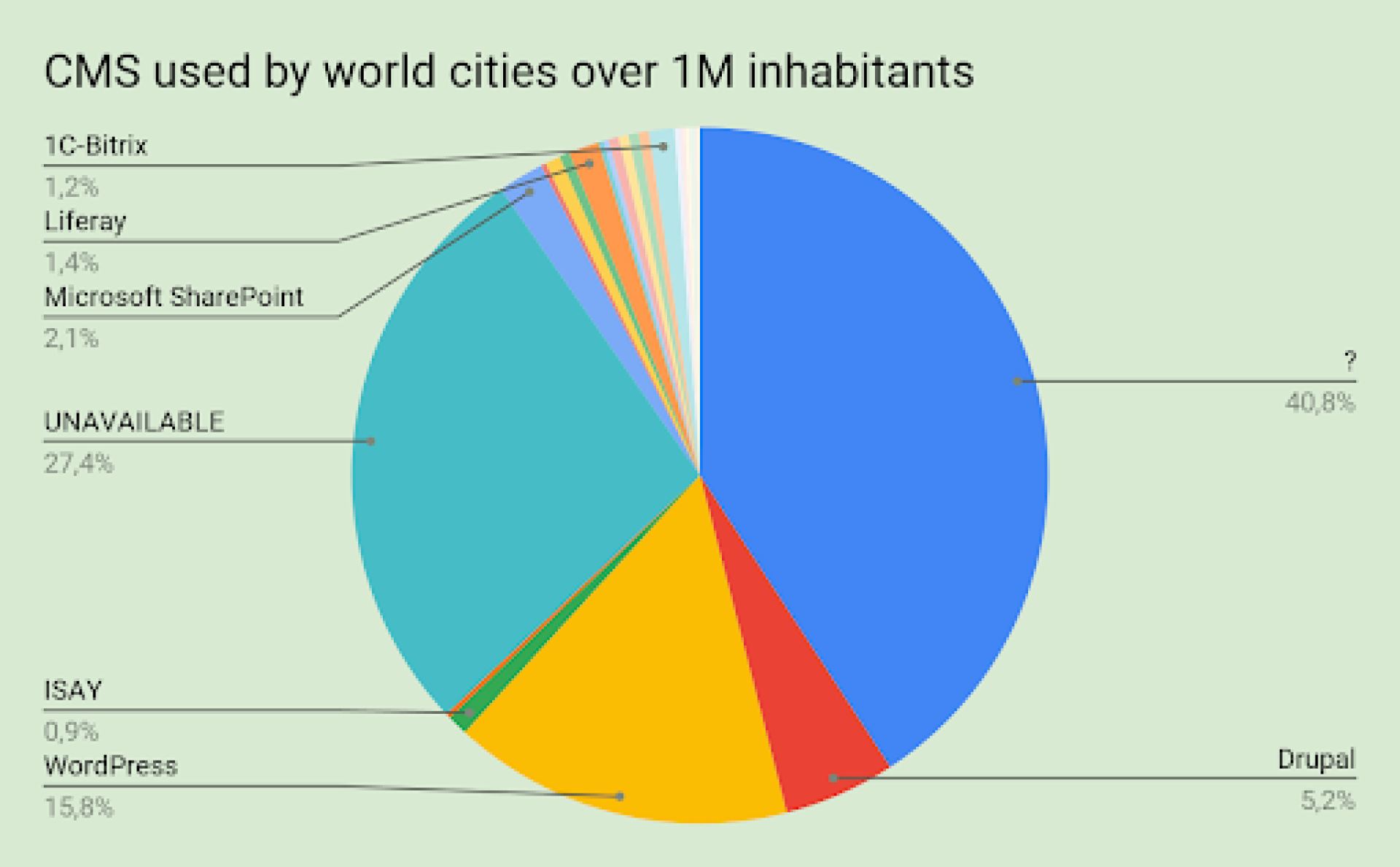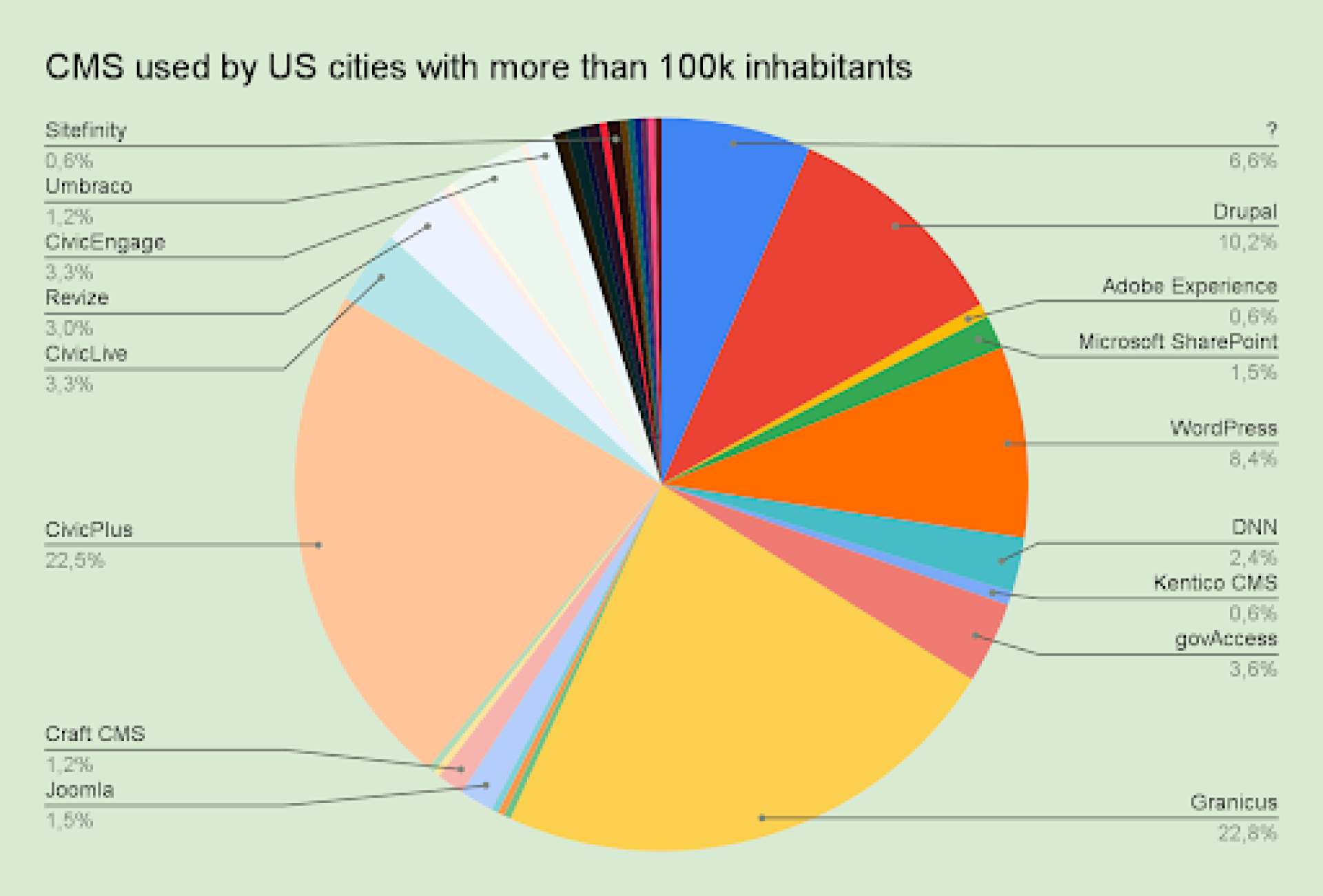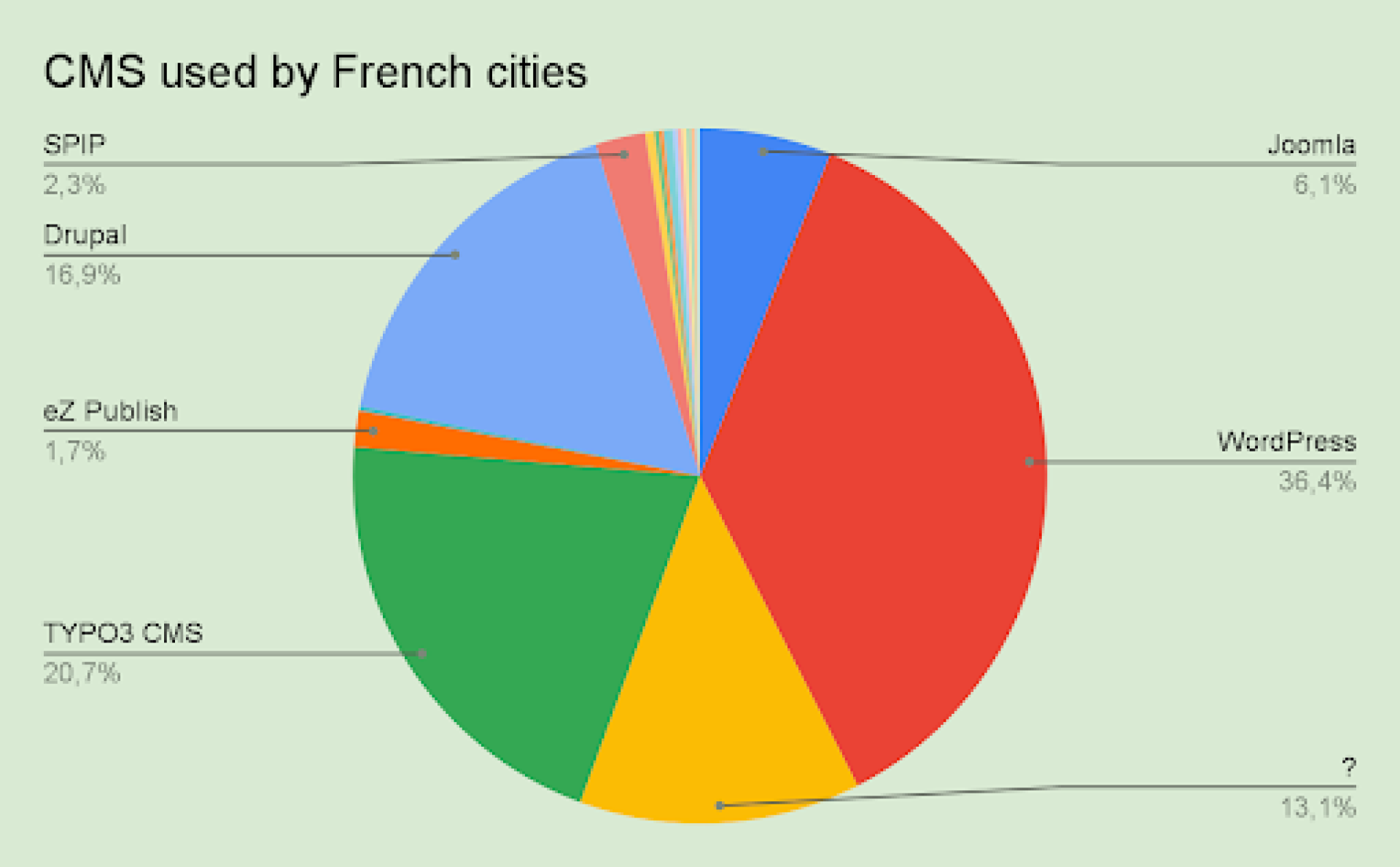Which CMS? Global City Website Trends Examined
It is quite obvious that public institutions should use open solutions to maintain transparency and avoid being too tied to commercial alternatives. However, is this the case in practice?
Recently, I've been researching the use of CMS systems on official city websites. I think the topic is very important on a global scale. In my opinion, the percentage of open-source engines on the market tells us a lot about each country. It also indicates how much the public sector relies on companies that produce proprietary applications.
The study's conclusions are very inconclusive. They depend strongly on the region of the world. The influence of European institutions on cities in the Union is evident, and the dominance of ASP.NET technology in North America is also clear. It seems that Drupal, along with other open-source initiatives, still needs a lot of promotion.
The Methodology
- The list of cities and their websites was taken from Polish and English Wikipedia. If the information was wrong, I contributed the correction.
- I created a local Wappalyzer instance, cloned from https://github.com/dochne/wappalyzer, slightly modified to better imitate real browsers. I ran it against each URL.
- The results were received manually. If the CMS remained undetected, I checked the website for possible information (located in the footer or code).
- After the manual check, I ran all remaining URLs against the CMSeeK instance. The CMS list for this application was updated if necessary (for Polish and US sites, I added some local proprietary engines).
The Report
I divided the report into a few categories:

466 cities in the world with more than 1 million inhabitants
In this category, WordPress (15.8%) is the clear leader. Drupal (5.2%) is in second place. Unfortunately, many sites (including 129 Chinese ones) are either inaccessible or unrecognizable. So, these results can be very inaccurate. In third place is Microsoft SharePoint (2.1%).
Drupal is used by: Delhi, Lahore, London, Bogotá, Pune, Los Angeles, Addis Abeba, Brisbane, Monrovia, Barcelona, Munich, Porto Alegre, Chandigarh, San Diego, Montevideo, Guarulhos, Zapopan, Ottawa, Edmonton

255 world capitals
WordPress (21.6%) and Drupal (13%) share the podium again. This time, Joomla took third place (2.2%). The PHP solutions, together with TYPO3, reach almost 40% of the market.
Drupal is used by: Addis Ababa, Andorra la Vella, Bogotá, Brazzaville, Brussels, Copenhagen, Dublin, Gaborone, Helsinki, London, London (administration), Luxembourg, Mariehamn, Monrovia, Montevideo, Nassau, Nouméa, Ottawa, Reykjavík, Riga, Tallinn, Thimphu, Washington, D.C.

92 Cities in the EU with more than 300k inhabitants
Drupal (18,5%) takes the lead, with TYPO3 (9.8%) and Liferay (9.8%) going head to head. What an interesting turn of events! WordPress (7.6%) stays off the podium. The proprietary systems are a long way behind.
Drupal is used by: Barcelona, Munich, Marseille, Helsinki, Copenhagen, Riga, Dublin, Genoa, Lyon, Toulouse, Tallinn, Szczecin, Florence, Alicante, Bielefeld, Mannheim.

All 1014 Polish cities
I included my home country in the report because I was curious about how it looks compared to the rest of the world. I adjusted CMSeeK to recognize Polish commercial CMS systems. This way, I could detect the engines of almost 80% of the sites. WordPress (23.1%) is again the winner, followed by Joomla (9%) and CMS-SPI (8.9%). 2ClickPortal® Cloud (8.3%), a SaaS solution for city website management, stays off the podium. Drupal gets only 4.3% of the pie.
Drupal is used by: Szczecin, Opole, Toruń, Koszalin, Jelenia Góra, Gliwice, Bielsko-Biała, and 36 other cities.

333 Cities in the US with more than 100k inhabitants
This part of the report took some effort, as most US city sites are inaccessible from Europe. I found a working VPN server and modified CMSeeK again to detect some proprietary systems. I recognized ~93% of the site engines. It seems that most of them are based on Granicus (22.8%, also called OpenCities) and CivicPlus (22.5%). In third place is Drupal (10.2%). Together with WordPress and Joomla, it gets 20.1% of the market. TYPO3 has not been detected at all.
Drupal is used by: Los Angeles, San Diego, Austin, San Francisco, Nashville, Washington D.C., Boston, Portland, Louisville, Detroit and 24 other cities.

76 UK cities
This part of the report may be inaccurate, as the definition of a city in the UK is slightly different. Drupal (17.4%) is the leader here, followed by WordPress (15.9%) and Umbraco (13%, open source based on ASP.NET). The CMS of 23 sites was not detected. It suggests either proprietary software or some government platform.
Drupal is used by: Westminster, Sheffield, Newcastle upon Tyne, Milton Keynes, Brighton & Hove, Wolverhampton, Plymouth, Aberdeen, Canterbury, St Albans, Dundee, and Wrexham.

82 largest German cities
I think Germany is a very open-source-friendly environment, but it is really hard to confirm this because of the large amount of unrecognized CMS. If we look at the recognized ones, TYPO3 (18.3%) seems to be the most popular. Drupal (7.3%) is in second place. Recently, German authorities announced some major investments in TYPO3, and we are probably seeing the first results.
Drupal is used by: München, Bielefeld, Mannheim, Potsdam, Jena, Moers

324 Benelux cities
The Benelux countries are very interesting research cases because they are all very close to the "core" of the European Union.
Belgium really impresses with the number of open solutions. PHP frameworks have "only" 28% market share, but the winner is Plone (34.4%), the GPL-based Python application.
Drupal is used by: Brussels, Ghent, Bruges, Leuven and 24 other cities.
The Netherlands is very different; TYPO3 (15.2%) is opening up the stakes, with Drupal (14%) and Green Valley CMS (14%, probably proprietary) behind it.
Drupal is used by: Zutphen, Appingedam, Delfzijl, Gennep, Venlo, Boxtel, Breda, Eindhoven, Geertruidenberg, Roosendaal, Edam, Haarlem, Hilversum, Purmerend, Schagen, Almelo, Delft, Gorinchem, Schiedam, Amersfoort, Goes
Luxembourg seems monolithic; 75% of the sites are based on WordPress. The capital, however, uses Drupal.


473 French cities
I waited for this surprise until the very end of the report. It turned out that WordPress (36.4%), Drupal (16.9%), TYPO3 (20.7%), and Joomla (6.1%) are used in 80% of French city cities!
Drupal is used by: Marseille, Lyon, Toulouse, Rennes, Saint-Étienne and 75 other cities.

Conclusion
The PHP open-source projects are very popular in most countries. However, I keep asking myself—why is it more profitable for many cities to use proprietary software?
Let's look at Poland. Out of 1013 cities, 84 have decided to use SaaS solutions. Over 400 municipalities prefer to use commercial tools. Drupal was found on only 43 sites. Even the new government platform does not seem to be open source. Is it a matter of lobbying? I don't think so.
Imagine announcing a public tender for creating a city website, where price is a major factor. Commercial CMS are mostly ready to use and well-tested in other cities. The software houses see no value in contributing their code, and no one encourages them to use GPL-like licenses.
Is Drupal powerful enough to compete with such adversaries? Well, of course, it is, but it also takes a lot of work to put it together. The typical city website contains news, events, maps, personal profiles, jobs, legal documents, and facility listings. It needs to be WCAG-compliant and accessible to all kinds of people. Basically, it's a lot of development, and more importantly, the results of that work should be released under the same open license. Obviously, it is more profitable to create a closed-source solution, but should public money be the source of such profits?
How can we reverse this dangerous trend without harm to the business community?
- First, we need to educate our authorities about the nature of open source. Looking at Poland, this seems like a Sisyphean task. National institutions should provide APIs for popular CMS to make their use more profitable. As a next step, they should specify the target license of the website code. I think this is what happened in France (80% of French cities use some kind of open PHP CMS). Is the GPL license a threat to business? Not at all. We should pay for the quality of the service and not for hiring the only developers of some proprietary CMS. We also have to be respectful of the public money and avoid paying for the same service over and over again.
- Second, we should take a closer look at the Drupal Recipes initiative. This could be a real game changer for the public sector. Right now, it is not enough to have contributed modules, themes or even distributions (I say this as a long-time distribution maintainer). Imagine installing Drupal with a few recipes like "City Events", "Jobs", and "News" and having an out-of-the-box MVP within minutes.
- Third, we need some good themes for different types of public institutions. Having similar themes may not be very attractive, but if you look at Poland again, almost 100 proprietary websites have identical templates because it is cheaper.
Data source
I put all the data into a Google spreadsheet under the CC-BY 4.0 license. Please comment if you have any relevant information about the cities.
Note: The vision of this web portal is to help promote news and stories around the Drupal community and promote and celebrate the people and organizations in the community. We strive to create and distribute our content based on these content policy. If you see any omission/variation on this please let us know in the comments below and we will try to address the issue as best we can.



























